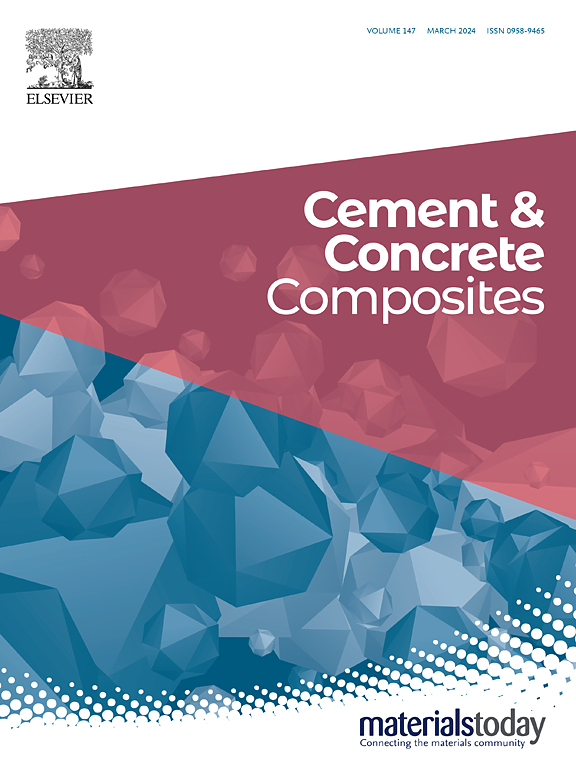LDH-based functionalized microcapsules: Multi-step active corrosion resistance strategy toward durable cementitious composites
IF 10.8
1区 工程技术
Q1 CONSTRUCTION & BUILDING TECHNOLOGY
引用次数: 0
Abstract
Corrosive ions such as Cl− seriously affect the durability and service state of cementitious composites. To solve this problem, the LDH-based functionalized microcapsules (LFMCs) with isophorone diisocyanate (IPDI) as core and layered double hydroxide (LDH)/poly(divinylbenzene) (PDVB) as composite wall were synthesized via Pickering emulsion photopolymerization to enhance active corrosion resistance. The wettability, chloride ion adsorption, self-healing functions were investigated. The electrochemical corrosion tests, including electrochemical impedance spectroscopy (EIS) and Tafel polarization measurements, were utilized to comprehensively assess the corrosion resistance. LFMCs can achieve multi-step active corrosion resistance for cementitious composites. Firstly, the microcapsules possessed hydrophobicity which can reduce the penetration of corrosive medium. Secondly, the microcapsules demonstrated a notable chloride ion adsorption capacity in simulated concrete pore solution (SCPS) with a maximum adsorption value of 22.791 mg/g. Thirdly, the microcapsules displayed self-healing performance in cement paste, which can further improve the permeability resistance of cement and enhance the corrosion resistance of rebars. LFMCs significantly enhanced the corrosion resistance of rebars. This work provides new insights into the durability enhancement for cementitious composites.
基于ldh的功能化微胶囊:迈向耐用胶凝复合材料的多步骤主动耐腐蚀策略
Cl-等腐蚀性离子严重影响胶凝复合材料的耐久性和使用状态。为了解决这一问题,采用Pickering乳剂光聚合法制备了以异佛尔酮二异氰酸酯(IPDI)为核心,层状双氢氧化物(LDH)/聚二乙烯基苯(PDVB)为复合壁的LDH基功能化微胶囊(LFMCs),以提高活性耐腐蚀性。研究了其润湿性、氯离子吸附、自愈功能。利用电化学阻抗谱(EIS)和Tafel极化测量等电化学腐蚀试验,对材料的耐蚀性进行综合评价。lfmc可以实现胶凝复合材料的多级活性耐蚀。首先,微胶囊具有疏水性,可以减少腐蚀介质的渗透;其次,微胶囊在模拟混凝土孔溶液(SCPS)中表现出显著的氯离子吸附能力,最大吸附值为22.791 mg/g。第三,微胶囊在水泥浆体中表现出自愈性能,可进一步提高水泥的抗渗性能,增强钢筋的抗腐蚀性能。lfmc显著提高了钢筋的耐蚀性。这项工作为增强胶凝复合材料的耐久性提供了新的见解。
本文章由计算机程序翻译,如有差异,请以英文原文为准。
求助全文
约1分钟内获得全文
求助全文
来源期刊

Cement & concrete composites
工程技术-材料科学:复合
CiteScore
18.70
自引率
11.40%
发文量
459
审稿时长
65 days
期刊介绍:
Cement & concrete composites focuses on advancements in cement-concrete composite technology and the production, use, and performance of cement-based construction materials. It covers a wide range of materials, including fiber-reinforced composites, polymer composites, ferrocement, and those incorporating special aggregates or waste materials. Major themes include microstructure, material properties, testing, durability, mechanics, modeling, design, fabrication, and practical applications. The journal welcomes papers on structural behavior, field studies, repair and maintenance, serviceability, and sustainability. It aims to enhance understanding, provide a platform for unconventional materials, promote low-cost energy-saving materials, and bridge the gap between materials science, engineering, and construction. Special issues on emerging topics are also published to encourage collaboration between materials scientists, engineers, designers, and fabricators.
 求助内容:
求助内容: 应助结果提醒方式:
应助结果提醒方式:


